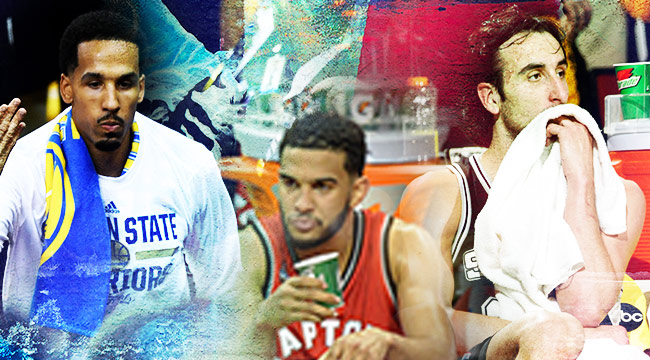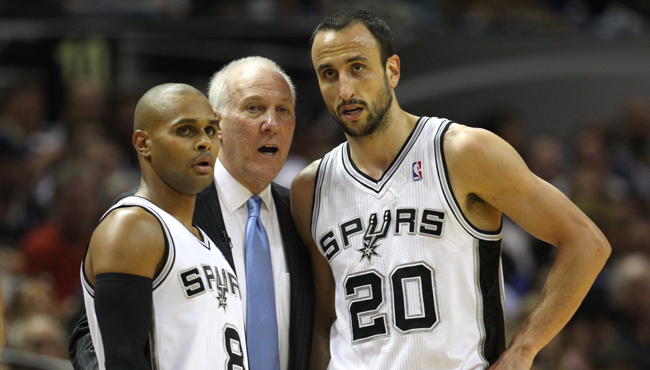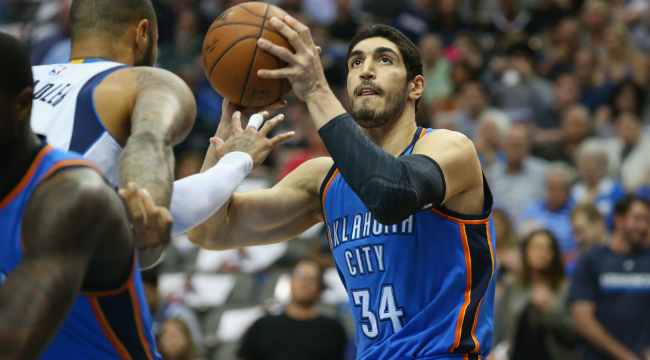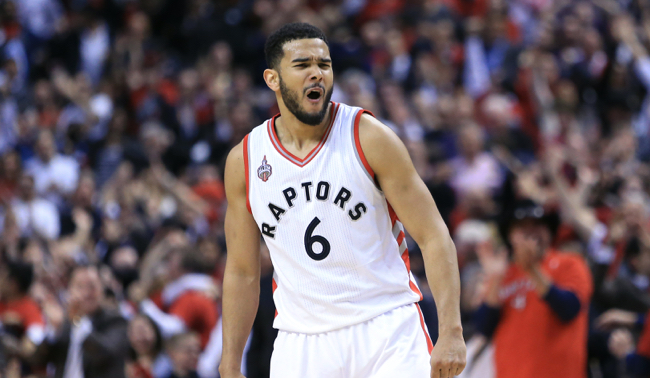
Necessity is certainly the mother of invention, but it’s been so much more than that for Steve Kerr.
The circumstances surrounding Draymond Green’s promotion during the reigning Coach of the Year’s first training camp with the Golden State Warriors are well known by now. If incumbent starter David Lee hadn’t been sidelined by a strained left hamstring for his team’s final preseason game and the ensuing seven weeks, the Warriors as we know them might not exist. Would Green have eventually forced his way into Golden State’s fabric with equal parts versatility and intensity? Perhaps, but the point remains that external factors are what began his meteoric rise to stardom.
Andre Iguodala, meanwhile, found himself in Lee’s position. A basic lifetime before he led the Warriors to a title, the 10-year veteran was told by a rookie coach he’d be coming off the bench for the first time in his career. Not due to promising wing Harrison Barnes maturing into a superior player, either, but because Golden State’s new motion-heavy attack needed a table setter – and Iguodala was the only one on the roster who could fill that role with free-agent acquisition Shaun Livingston also hampered by injuries.
“Like I said, our whole focus with this team is to try to continue to improve and make the most out of our unit,” Iguodala explained to The Bay Area News Group in October 2014, “and we have so much depth, there are opportunities for us to get where everybody wants to be.”
That one-for-all mindset is increasingly prevalent throughout the league. Starting games has never been an accurate indicator of a player’s worth to his team, and there’s no finer example of that reality than Iguodala blossoming into basketball’s preeminent sixth man while the Warriors became a juggernaut.
But the 2015 Finals MVP isn’t the only high-level performer whose surroundings make him a perfect fit off the bench. This is a team sport; individual ability alone will never decide a player’s place in the league. Sacrifice is paramount in basketball, and roster-specific context can make it necessary for even the most-gifted players.
Iguodala, obviously, is the starting-quality reserve who leads that pack. These similarly talented bench players, though, also find themselves among it.
Patty Mills and Manu Ginobili

No duo in the league better exemplifies the symbiotic relationship reserves share with their on-court peers than Mills and Ginobili. They rely on each other to be the best versions of themselves. Mills couldn’t race around screens for quick-hitting jumpers if Ginobili wasn’t such a comfortable playmaker, and Ginobili couldn’t be the second unit’s primary ball handler if Mills had to have it in his hands to thrive. Theirs is a perfect marriage in terms of schematic fit as much as it is a stylistic one. The San Antonio machine can sometimes chug along on both ends without the dynamism that separates it from other well-oiled outfits, but not when Mills and Ginobili are on the floor. These guys change the game – for both good and bad.
The positives brought forth by such talented, energetic players far outweigh the negatives. The Spurs’ net rating with Mills and Ginobili in the lineup last season was a sterling +14.9, the second-best mark among San Antonio tandems that notched at least 700 minutes and one accomplished with equal prowess on each side of the ball. Caveat: Those units also had a team-high turnover ratio of 15.5, an inevitable byproduct of kinetic energy like this.

Such is the give and take Mills and Ginobili represent. Considering the Spurs’ bench has been a driving force behind its success for years, though, it’s certainly a “risk” worth taking for the notoriously stringent Gregg Popovich on a nightly basis.
Shaun Livingston
After Game 1 of the 2016 NBA Finals, Draymond Green explained what makes Shaun Livingston such a valuable player for the Warriors.
“Shaun’s a guy who has battled through much more than having to step up in a game. He’s been from the top to the bottom and back. And when you go through so much in life and his career, I mean, it makes stepping up in the game easy.
Obviously, he’s a competitor. One thing about Shaun is he’s never going to get outside of who he is. He’s going to do what he does, and he’s going to get to his spots and he’s going to raise up and knock shots down.
And he’s a very smart player, so he knows how to get behind defense and find openings. And all that stuff helps his team out, and him stepping up the way he did tonight was huge for us.”
Golden State doesn’t count on its super-sized floor general to score 20 points off the bench every game. Livingston is simply another piece of the puzzle in Oakland, a playmaker who helps create shots for his über-talented teammates and a defender who allows the Warriors to switch with impunity and play bigger than their collective size suggests. He’s a canny, active cutter and always makes the right play in transition. Any player possessing those rare attributes would find a job in the league.
What makes Livingston stand out out even further, though, is his knack for exploiting mismatches. He shot an elite 50.6 percent from the post last season, and led the league by connecting on 49.2 percent of his pull-up jumpers. There’s only so much resistance opposing smalls – even bigger guys like Iman Shumpert – can offer when sized up by a 6-foot-7 guard with such natural shot-making ability.

One problem: Livingston’s range doesn’t extend to the arc. He attempted just 12 three-pointers in 2015-16 after hinting he’d venture outside more frequently before the season began, and said something similar at media day earlier this week.
Shaun Livingston says he has been pushed to take more threes by Bob Myers but that his midrange game is his " bread and butter."
— Tim Bontemps (@TimBontemps) September 26, 2016
It’d be a minor shock if Livingston got in on the splashing fun this season. Players of such experience rarely make that type of change so late in their careers. No matter, though; his bread and butter is more than good enough.
Enes Kanter

The Thunder’s bucket-getting big man is the most objectively flawed player on this list. There’s no hiding Kanter defensively. Despite subtle improvements in effort and awareness on that end of the floor, the four-year veteran is still among the very worst interior defenders in the NBA. Not only did his -1.50 defensive real plus-minus rank second-to-last among centers, but the Thunder allow a team-worst 109.5 points per 100 possessions when he was on the court, and the opposition constantly put Kanter through a blender of high pick-and-rolls and off-ball misdirection.
Even so, the 24-year-old’s supreme offensive influence still makes him one of the most valuable reserves in the league – especially now that Kevin Durant bailed on Oklahoma City for the Bay.
One of the most fascinating questions facing the Thunder this season is how often Billy Donovan will employ the super-sized frontcourt that pushed and shoved the Spurs into submission last spring. Doing so will undoubtedly be more difficult without Durant around to occupy multiple defenders, and the timeline of Steven Adams’ evolution into a top-tier all-court defender also looms large in that regard. Stuff like this does, too:

Kanter shot a career-best 45 percent on mid-range jumpers last season, and even made 10 of his 21 three-point attempts before coming back to earth in the playoffs. At the very least, expect the fifth-year man to experiment more with triples from either corner this season, a possibility that would make lineups including he and Adams more sustainable offensively when they aren’t beasting on Oklahoma City misses. That’s especially important, too, because it’s difficult to imagine units featuring Kanter at center becoming viable defensively absent the long arms and steadying presence of Durant and Serge Ibaka.
This is a big season for the former top-five pick. Adams is the Thunder’s present and future up front, and the length of Kanter’s tenure in Oklahoma City could largely depend on that tandem’s success as Sam Presti navigates life post-Durant. Otherwise, he might continue his career as basketball’s most notorious one-way player elsewhere.
Cory Joseph and Norman Powell

It speaks volumes of Joseph’s solid all-around game that he made such an impact during his first season in Toronto despite regressing as a three-point shooter. If the 25-year-old improves and Powell makes good on a surprisingly adept rookie year from beyond the arc? This lunch-pail duo will find itself closing games on the floor despite beginning them on the bench.
Joseph, though just 6-foot-3 and an above-average athlete at best, proved Kyle Lowry’s top backcourt partner in 2015-16. Units featuring both defensive-minded guards boasted a +12.7 net rating, the second-highest mark on the Raptors among duos that notched at least 500 minutes – and Joseph was a part of the other one, too. It’s not hard to see why. He’s a patient, nuanced pick-and-roll operator, compensates for his lack of explosive athleticism with crafty finishes in the paint, and relishes the task of defending guards of all sizes and styles.

Powell is cut from a similar cloth. The 43rd pick of the 2015 draft, he became a permanent fixture of Dwane Casey’s rotation in March of his rookie season and is poised to remain one for the long haul. He’s arguably Toronto’s best defensive option against high-usage wings, and uses an enviable blend of all-around athleticism and length to play much bigger than his 6-foot-4 height suggests. Most encouraging? Powell showed signs of becoming more than a 3-and-D role player at Las Vegas Summer League in July, both initiating offense on the ball and proving his chops as a primary scorer.

But the real value provided by Joseph and Powell isn’t about what they bring to the table in a vacuum. The presence of two players who can so comfortably fill multiple roles alongside established stars allows Toronto crucial matchup and lineup flexibility it lacked last season. Small-ball should be a viable part of the Raptors’ attack in 2016-17, and Lowry and DeRozan – the latter of whom is overmatched in this capacity anyway – won’t be forced to check the opposition’s top offensive threat.
The sweeping benefits gleaned from those potential developments can’t be discounted, and are the biggest reason why Joseph and Powell find fixtures in Toronto’s plans – even though they might have based on individual ability by itself, too.






